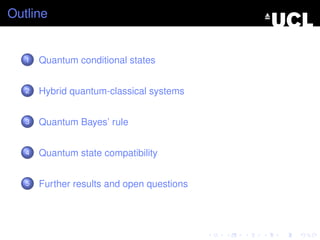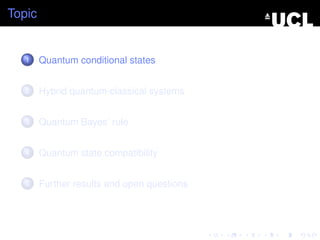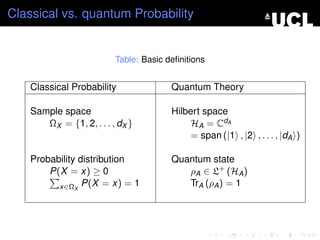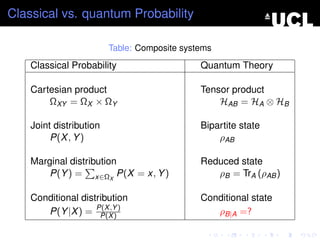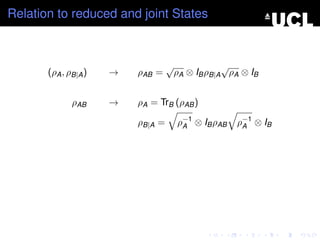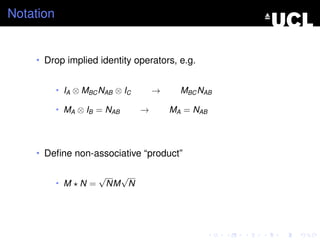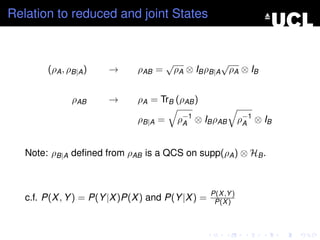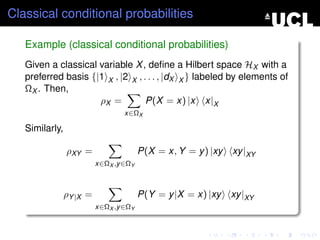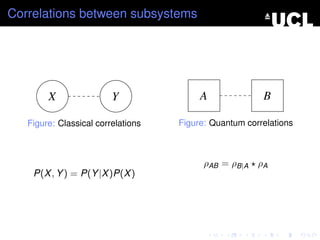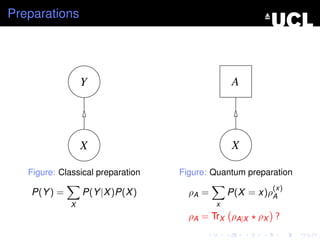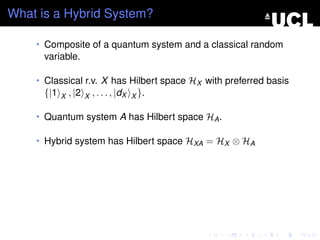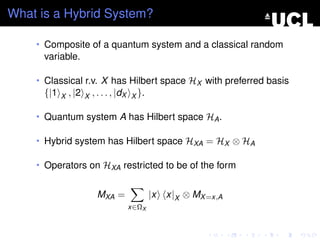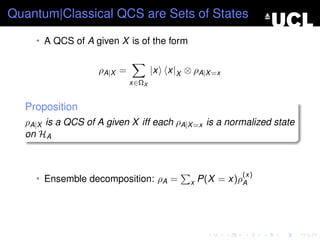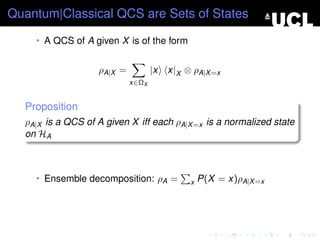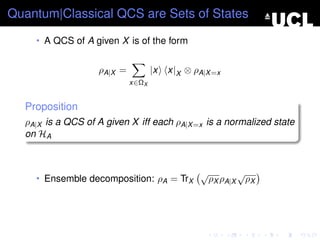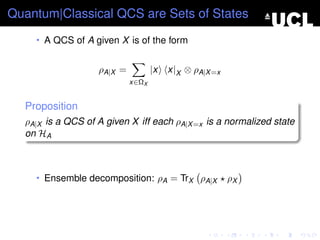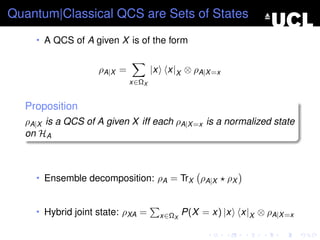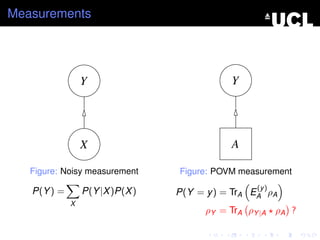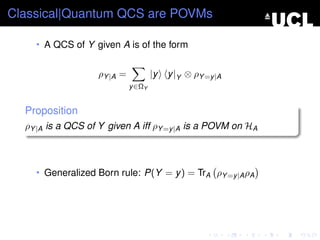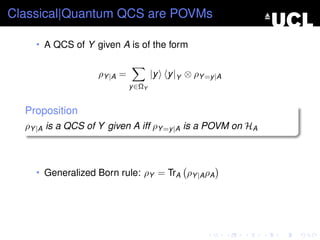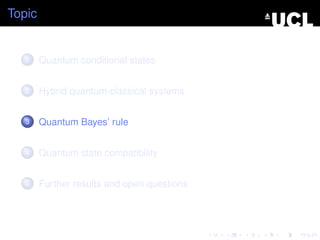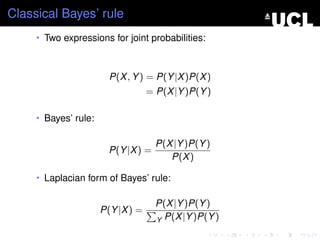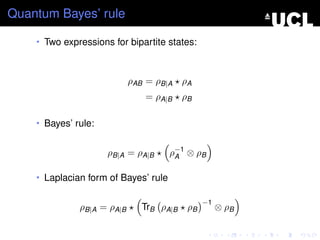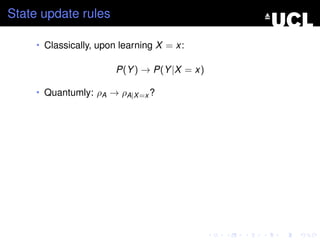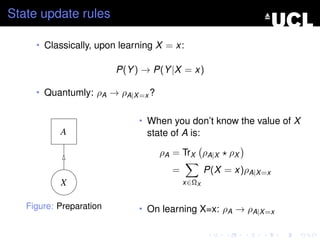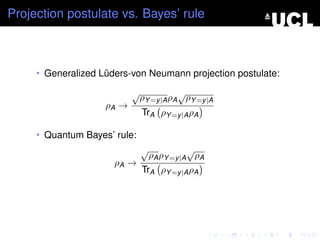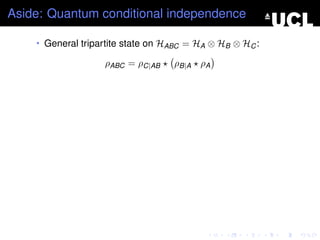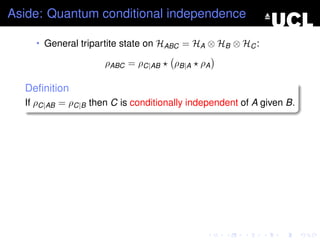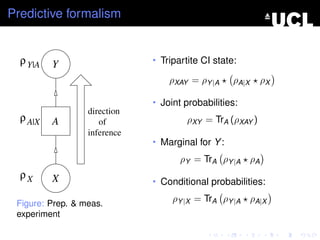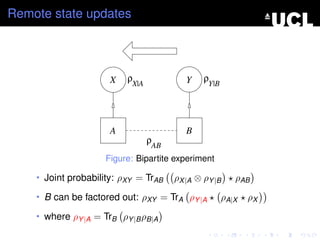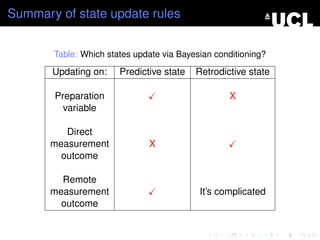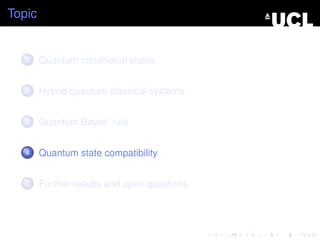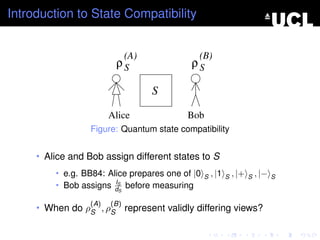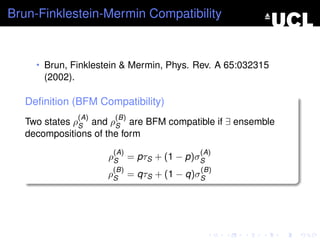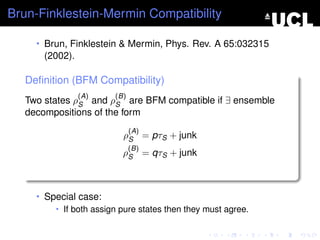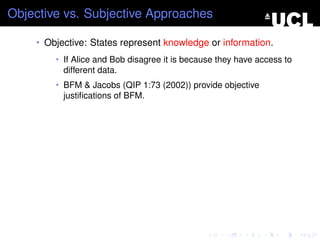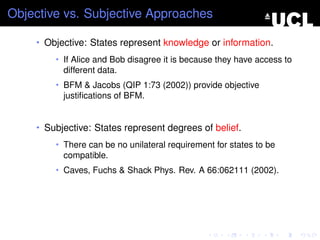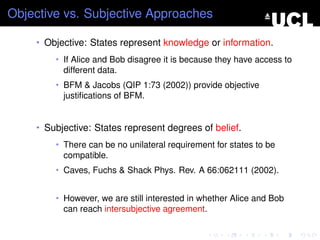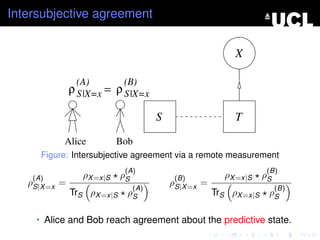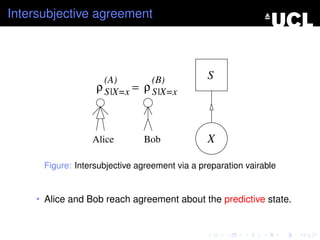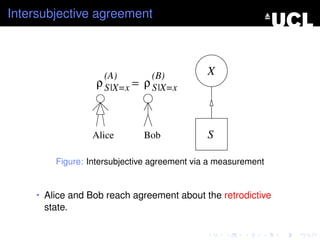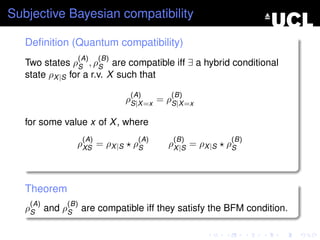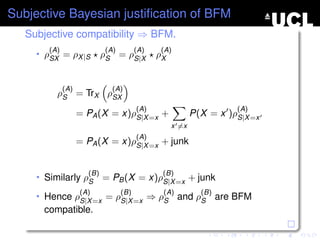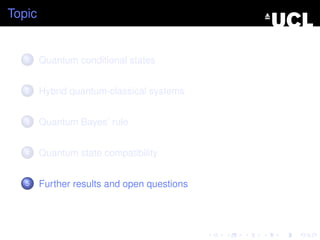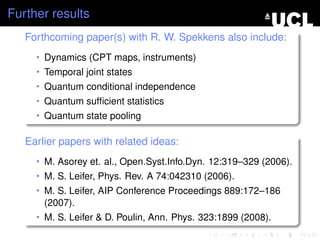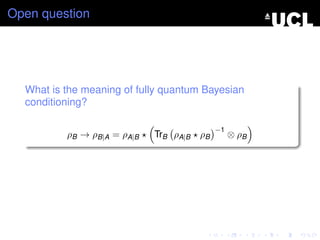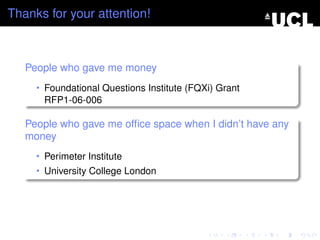Imperial20101215
- 1. Quantum conditional states, Bayesâ rule, and state compatibility M. S. Leifer (UCL) Joint work with R. W. Spekkens (Perimeter) Imperial College QI Seminar 14th December 2010
- 2. Outline 1 Quantum conditional states 2 Hybrid quantum-classical systems 3 Quantum Bayesâ rule 4 Quantum state compatibility 5 Further results and open questions
- 3. Topic 1 Quantum conditional states 2 Hybrid quantum-classical systems 3 Quantum Bayesâ rule 4 Quantum state compatibility 5 Further results and open questions
- 4. Classical vs. quantum Probability Table: Basic deï¬nitions Classical Probability Quantum Theory Sample space Hilbert space â¦X = {1, 2, . . . , dX } HA = CdA = span (|1 , |2 , . . . , |dA ) Probability distribution Quantum state P(X = x) ⥠0 ÏA â L+ (HA ) xââ¦X P(X = x) = 1 TrA (ÏA ) = 1
- 5. Classical vs. quantum Probability Table: Composite systems Classical Probability Quantum Theory Cartesian product Tensor product â¦XY = â¦X à â¦Y HAB = HA â HB Joint distribution Bipartite state P(X , Y ) ÏAB Marginal distribution Reduced state P(Y ) = xââ¦X P(X = x, Y ) ÏB = TrA (ÏAB ) Conditional distribution Conditional state P(Y |X ) = P(X ,Y ) P(X ) ÏB|A =?
- 6. Deï¬nition of QCS Deï¬nition A quantum conditional state of B given A is a positive operator ÏB|A on HAB = HA â HB that satisï¬es TrB ÏB|A = IA . c.f. P(Y |X ) is a positive function on â¦XY = â¦X à â¦Y that satisï¬es P(Y = y |X ) = 1. y ââ¦Y
- 7. Relation to reduced and joint States â â (ÏA , ÏB|A ) â ÏAB = ÏA â IB ÏB|A ÏA â IB ÏAB â ÏA = TrB (ÏAB ) ÏB|A = Ïâ1 â IB ÏAB A Ïâ1 â IB A
- 8. Relation to reduced and joint States â â (ÏA , ÏB|A ) â ÏAB = ÏA â IB ÏB|A ÏA â IB ÏAB â ÏA = TrB (ÏAB ) ÏB|A = Ïâ1 â IB ÏAB A Ïâ1 â IB A Note: ÏB|A deï¬ned from ÏAB is a QCS on supp(ÏA ) â HB .
- 9. Relation to reduced and joint States â â (ÏA , ÏB|A ) â ÏAB = ÏA â IB ÏB|A ÏA â IB ÏAB â ÏA = TrB (ÏAB ) ÏB|A = Ïâ1 â IB ÏAB A Ïâ1 â IB A Note: ÏB|A deï¬ned from ÏAB is a QCS on supp(ÏA ) â HB . P(X ,Y ) c.f. P(X , Y ) = P(Y |X )P(X ) and P(Y |X ) = P(X )
- 10. Notation ⢠Drop implied identity operators, e.g. ⢠IA â MBC NAB â IC â MBC NAB ⢠MA â IB = NAB â MA = NAB ⢠Deï¬ne non-associative âproductâ â â ⢠M N= NM N
- 11. Relation to reduced and joint States â â (ÏA , ÏB|A ) â ÏAB = ÏA â IB ÏB|A ÏA â IB ÏAB â ÏA = TrB (ÏAB ) ÏB|A = Ïâ1 â IB ÏAB A Ïâ1 â IB A Note: ÏB|A deï¬ned from ÏAB is a QCS on supp(ÏA ) â HB . P(X ,Y ) c.f. P(X , Y ) = P(Y |X )P(X ) and P(Y |X ) = P(X )
- 12. Relation to reduced and joint states (ÏA , ÏB|A ) â ÏAB = ÏB|A ÏA ÏAB â ÏA = TrB (ÏAB ) ÏB|A = ÏAB Ïâ1 A Note: ÏB|A deï¬ned from ÏAB is a QCS on supp(ÏA ) â HB . P(X ,Y ) c.f. P(X , Y ) = P(Y |X )P(X ) and P(Y |X ) = P(X )
- 13. Classical conditional probabilities Example (classical conditional probabilities) Given a classical variable X , deï¬ne a Hilbert space HX with a preferred basis {|1 X , |2 X , . . . , |dX X } labeled by elements of â¦X . Then, ÏX = P(X = x) |x x|X xââ¦X Similarly, ÏXY = P(X = x, Y = y ) |xy xy |XY xââ¦X ,y ââ¦Y ÏY |X = P(Y = y |X = x) |xy xy |XY xââ¦X ,y ââ¦Y
- 14. Topic 1 Quantum conditional states 2 Hybrid quantum-classical systems 3 Quantum Bayesâ rule 4 Quantum state compatibility 5 Further results and open questions
- 15. Correlations between subsystems X Y A B Figure: Classical correlations Figure: Quantum correlations ÏAB = ÏB|A ÏA P(X , Y ) = P(Y |X )P(X )
- 16. Preparations Y A X X Figure: Classical preparation Figure: Quantum preparation (x) P(Y ) = P(Y |X )P(X ) ÏA = P(X = x)ÏA X x ÏA = TrX ÏA|X ÏX ?
- 17. What is a Hybrid System? ⢠Composite of a quantum system and a classical random variable. ⢠Classical r.v. X has Hilbert space HX with preferred basis {|1 X , |2 X , . . . , |dX X }. ⢠Quantum system A has Hilbert space HA . ⢠Hybrid system has Hilbert space HXA = HX â HA
- 18. What is a Hybrid System? ⢠Composite of a quantum system and a classical random variable. ⢠Classical r.v. X has Hilbert space HX with preferred basis {|1 X , |2 X , . . . , |dX X }. ⢠Quantum system A has Hilbert space HA . ⢠Hybrid system has Hilbert space HXA = HX â HA ⢠Operators on HXA restricted to be of the form MXA = |x x|X â MX =x,A xââ¦X
- 19. Quantum|Classical QCS are Sets of States ⢠A QCS of A given X is of the form ÏA|X = |x x|X â ÏA|X =x xââ¦X Proposition ÏA|X is a QCS of A given X iff each ÏA|X =x is a normalized state on HA (x) ⢠Ensemble decomposition: ÏA = x P(X = x)ÏA
- 20. Quantum|Classical QCS are Sets of States ⢠A QCS of A given X is of the form ÏA|X = |x x|X â ÏA|X =x xââ¦X Proposition ÏA|X is a QCS of A given X iff each ÏA|X =x is a normalized state on HA ⢠Ensemble decomposition: ÏA = x P(X = x)ÏA|X =x
- 21. Quantum|Classical QCS are Sets of States ⢠A QCS of A given X is of the form ÏA|X = |x x|X â ÏA|X =x xââ¦X Proposition ÏA|X is a QCS of A given X iff each ÏA|X =x is a normalized state on HA ⢠Ensemble decomposition: ÏA = TrX ÏX ÏA|X
- 22. Quantum|Classical QCS are Sets of States ⢠A QCS of A given X is of the form ÏA|X = |x x|X â ÏA|X =x xââ¦X Proposition ÏA|X is a QCS of A given X iff each ÏA|X =x is a normalized state on HA â â ⢠Ensemble decomposition: ÏA = TrX ÏX ÏA|X ÏX
- 23. Quantum|Classical QCS are Sets of States ⢠A QCS of A given X is of the form ÏA|X = |x x|X â ÏA|X =x xââ¦X Proposition ÏA|X is a QCS of A given X iff each ÏA|X =x is a normalized state on HA ⢠Ensemble decomposition: ÏA = TrX ÏA|X ÏX
- 24. Quantum|Classical QCS are Sets of States ⢠A QCS of A given X is of the form ÏA|X = |x x|X â ÏA|X =x xââ¦X Proposition ÏA|X is a QCS of A given X iff each ÏA|X =x is a normalized state on HA ⢠Ensemble decomposition: ÏA = TrX ÏA|X ÏX ⢠Hybrid joint state: ÏXA = xââ¦X P(X = x) |x x|X â ÏA|X =x
- 25. Preparations Y A X X Figure: Classical preparation Figure: Quantum preparation (x) P(Y ) = P(Y |X )P(X ) ÏA = P(X = x)ÏA X x ÏA = TrX ÏA|X ÏX
- 26. Measurements Y Y X A Figure: Noisy measurement Figure: POVM measurement (y ) P(Y ) = P(Y |X )P(X ) P(Y = y ) = TrA EA ÏA X ÏY = TrA ÏY |A ÏA ?
- 27. Classical|Quantum QCS are POVMs ⢠A QCS of Y given A is of the form ÏY |A = |y y |Y â ÏY =y |A y ââ¦Y Proposition ÏY |A is a QCS of Y given A iff ÏY =y |A is a POVM on HA (y ) ⢠Generalized Born rule: P(Y = y ) = TrA EA ÏA
- 28. Classical|Quantum QCS are POVMs ⢠A QCS of Y given A is of the form ÏY |A = |y y |Y â ÏY =y |A y ââ¦Y Proposition ÏY |A is a QCS of Y given A iff ÏY =y |A is a POVM on HA ⢠Generalized Born rule: P(Y = y ) = TrA ÏY =y |A ÏA
- 29. Classical|Quantum QCS are POVMs ⢠A QCS of Y given A is of the form ÏY |A = |y y |Y â ÏY =y |A y ââ¦Y Proposition ÏY |A is a QCS of Y given A iff ÏY =y |A is a POVM on HA ⢠Generalized Born rule: ÏY = TrA ÏY |A ÏA
- 30. Classical|Quantum QCS are POVMs ⢠A QCS of Y given A is of the form ÏY |A = |y y |Y â ÏY =y |A y ââ¦Y Proposition ÏY |A is a QCS of Y given A iff ÏY =y |A is a POVM on HA â â ⢠Generalized Born rule: ÏY = TrA ÏA ÏY |A ÏA
- 31. Classical|Quantum QCS are POVMs ⢠A QCS of Y given A is of the form ÏY |A = |y y |Y â ÏY =y |A y ââ¦Y Proposition ÏY |A is a QCS of Y given A iff ÏY =y |A is a POVM on HA ⢠Generalized Born rule: ÏY = TrA ÏY |A ÏA
- 32. Classical|Quantum QCS are POVMs ⢠A QCS of Y given A is of the form ÏY |A = |y y |Y â ÏY =y |A y ââ¦Y Proposition ÏY |A is a QCS of Y given A iff ÏY =y |A is a POVM on HA ⢠Generalized Born rule: ÏY = TrA ÏY |A ÏA â â ⢠Hybrid joint state: ÏYA = y ââ¦Y |y y |Y â ÏA ÏY =y |A ÏA
- 33. Topic 1 Quantum conditional states 2 Hybrid quantum-classical systems 3 Quantum Bayesâ rule 4 Quantum state compatibility 5 Further results and open questions
- 34. Classical Bayesâ rule ⢠Two expressions for joint probabilities: P(X , Y ) = P(Y |X )P(X ) = P(X |Y )P(Y ) ⢠Bayesâ rule: P(X |Y )P(Y ) P(Y |X ) = P(X ) ⢠Laplacian form of Bayesâ rule: P(X |Y )P(Y ) P(Y |X ) = Y P(X |Y )P(Y )
- 35. Quantum Bayesâ rule ⢠Two expressions for bipartite states: ÏAB = ÏB|A ÏA = ÏA|B ÏB ⢠Bayesâ rule: ÏB|A = ÏA|B Ïâ1 â ÏB A ⢠Laplacian form of Bayesâ rule â1 ÏB|A = ÏA|B TrB ÏA|B ÏB â ÏB
- 36. State/POVM duality ⢠A hybrid joint state can be written two ways: ÏXA = ÏA|X ÏX = ÏX |A ÏA ⢠The two representations are connected via Bayesâ rule: â1 ÏX |A = ÏA|X ÏX â TrX ÏA|X ÏX â1 ÏA|X = ÏX |A TrA ÏX |A ÏA â ÏA â â P(X = x)ÏA|X =x ÏA ÏX =x|A ÏA ÏX =x|A = ÏA|X =x = x ââ¦X P(X = x )ÏA|X =x TrA ÏX =x|A ÏA
- 37. State update rules ⢠Classically, upon learning X = x: P(Y ) â P(Y |X = x) ⢠Quantumly: ÏA â ÏA|X =x ?
- 38. State update rules ⢠Classically, upon learning X = x: P(Y ) â P(Y |X = x) ⢠Quantumly: ÏA â ÏA|X =x ? ⢠When you donât know the value of X A state of A is: ÏA = TrX ÏA|X ÏX = P(X = x)ÏA|X =x X xââ¦X Figure: Preparation ⢠On learning X=x: ÏA â ÏA|X =x
- 39. State update rules ⢠Classically, upon learning Y = y : P(X ) â P(X |Y = y ) ⢠Quantumly: ÏA â ÏA|Y =y ? Y ⢠When you donât know the value of Y state of A is: ÏA = TrY ÏY |A ÏA A ⢠On learning Y=y: ÏA â ÏA|Y =y ? Figure: Measurement
- 40. Projection postulate vs. Bayesâ rule ⢠Generalized Lüders-von Neumann projection postulate: â â ÏY =y |A ÏA ÏY =y |A ÏA â TrA ÏY =y |A ÏA ⢠Quantum Bayesâ rule: â â ÏA ÏY =y |A ÏA ÏA â TrA ÏY =y |A ÏA
- 41. Aside: Quantum conditional independence ⢠General tripartite state on HABC = HA â HB â HC : ÏABC = ÏC|AB ÏB|A ÏA
- 42. Aside: Quantum conditional independence ⢠General tripartite state on HABC = HA â HB â HC : ÏABC = ÏC|AB ÏB|A ÏA Deï¬nition If ÏC|AB = ÏC|B then C is conditionally independent of A given B.
- 43. Aside: Quantum conditional independence ⢠General tripartite state on HABC = HA â HB â HC : ÏABC = ÏC|AB ÏB|A ÏA Deï¬nition If ÏC|AB = ÏC|B then C is conditionally independent of A given B. Theorem ÏC|AB = ÏC|B iff ÏA|BC = ÏA|B
- 44. Aside: Quantum conditional independence ⢠General tripartite state on HABC = HA â HB â HC : ÏABC = ÏC|AB ÏB|A ÏA Deï¬nition If ÏC|AB = ÏC|B then C is conditionally independent of A given B. Theorem ÏC|AB = ÏC|B iff ÏA|BC = ÏA|B Corollary ÏABC = ÏC|B ÏB|A ÏA iff ÏABC = ÏA|B ÏB|C ÏC
- 45. Predictive formalism Ï Y|A Y ⢠Tripartite CI state: ÏXAY = ÏY |A ÏA|X ÏX ⢠Joint probabilities: direction Ï A|X A of ÏXY = TrA (ÏXAY ) inference ⢠Marginal for Y : ÏY = TrA ÏY |A ÏA ÏX X ⢠Conditional probabilities: Figure: Prep. & meas. ÏY |X = TrA ÏY |A ÏA|X experiment
- 46. Retrodictive formalism ⢠Due to symmetry of CI: Ï Y|A Y ÏXAY = ÏX |A ÏA|Y ÏY ⢠Marginal for X : ÏX = TrA ÏX |A ÏA direction Ï A|X A of ⢠Conditional probabilities: inference ÏX |Y = TrA ÏX |A ÏA|Y ⢠Bayesian update: ÏX X ÏA â ÏA|Y =y Figure: Prep. & meas. ⢠c.f. Barnett, Pegg & Jeffers, J. experiment Mod. Opt. 47:1779 (2000).
- 47. Remote state updates X ÏX|A Y ÏY|B A B Ï AB Figure: Bipartite experiment ⢠Joint probability: ÏXY = TrAB ÏX |A â ÏY |B ÏAB ⢠B can be factored out: ÏXY = TrA ÏY |A ÏA|X ÏX ⢠where ÏY |A = TrB ÏY |B ÏB|A
- 48. Summary of state update rules Table: Which states update via Bayesian conditioning? Updating on: Predictive state Retrodictive state Preparation X variable Direct measurement X outcome Remote measurement Itâs complicated outcome
- 49. Topic 1 Quantum conditional states 2 Hybrid quantum-classical systems 3 Quantum Bayesâ rule 4 Quantum state compatibility 5 Further results and open questions
- 50. Introduction to State Compatibility (A) (B) ÏS ÏS S Alice Bob Figure: Quantum state compatibility ⢠Alice and Bob assign different states to S ⢠e.g. BB84: Alice prepares one of |0 S , |1 S , |+ S , |â S I ⢠Bob assigns dS before measuring S (A) (B) ⢠When do ÏS , ÏS represent validly differing views?
- 51. Brun-Finklestein-Mermin Compatibility ⢠Brun, Finklestein & Mermin, Phys. Rev. A 65:032315 (2002). Deï¬nition (BFM Compatibility) (A) (B) Two states ÏS and ÏS are BFM compatible if â ensemble decompositions of the form (A) (A) ÏS = pÏS + (1 â p)ÏS (B) (B) ÏS = qÏS + (1 â q)ÏS
- 52. Brun-Finklestein-Mermin Compatibility ⢠Brun, Finklestein & Mermin, Phys. Rev. A 65:032315 (2002). Deï¬nition (BFM Compatibility) (A) (B) Two states ÏS and ÏS are BFM compatible if â ensemble decompositions of the form (A) ÏS = pÏS + junk (B) ÏS = qÏS + junk
- 53. Brun-Finklestein-Mermin Compatibility ⢠Brun, Finklestein & Mermin, Phys. Rev. A 65:032315 (2002). Deï¬nition (BFM Compatibility) (A) (B) Two states ÏS and ÏS are BFM compatible if â ensemble decompositions of the form (A) ÏS = pÏS + junk (B) ÏS = qÏS + junk ⢠Special case: ⢠If both assign pure states then they must agree.
- 54. Objective vs. Subjective Approaches ⢠Objective: States represent knowledge or information. ⢠If Alice and Bob disagree it is because they have access to different data. ⢠BFM & Jacobs (QIP 1:73 (2002)) provide objective justiï¬cations of BFM.
- 55. Objective vs. Subjective Approaches ⢠Objective: States represent knowledge or information. ⢠If Alice and Bob disagree it is because they have access to different data. ⢠BFM & Jacobs (QIP 1:73 (2002)) provide objective justiï¬cations of BFM. ⢠Subjective: States represent degrees of belief. ⢠There can be no unilateral requirement for states to be compatible. ⢠Caves, Fuchs & Shack Phys. Rev. A 66:062111 (2002).
- 56. Objective vs. Subjective Approaches ⢠Objective: States represent knowledge or information. ⢠If Alice and Bob disagree it is because they have access to different data. ⢠BFM & Jacobs (QIP 1:73 (2002)) provide objective justiï¬cations of BFM. ⢠Subjective: States represent degrees of belief. ⢠There can be no unilateral requirement for states to be compatible. ⢠Caves, Fuchs & Shack Phys. Rev. A 66:062111 (2002). ⢠However, we are still interested in whether Alice and Bob can reach intersubjective agreement.
- 57. Subjective Bayesian Compatibility (A) (B) ÏS ÏS S Alice Bob Figure: Quantum compatibility
- 58. Intersubjective agreement X (A) (B) ÏS = ÏS S T Alice Bob Figure: Intersubjective agreement via a remote measurement ⢠Alice and Bob agree on the model for X (A) (B) ÏX |S = ÏX |S = ÏX |S , ÏX |S = TrT ÏX |T ÏT |S
- 59. Intersubjective agreement X (A) (B) Ï S |X=x = Ï S |X=x S T Alice Bob Figure: Intersubjective agreement via a remote measurement (A) (B) (A) ÏX =x|S ÏS (B) ÏX =x|S ÏS ÏS|X =x = ÏS|X =x = (A) (B) TrS ÏX =x|S ÏS TrS ÏX =x|S ÏS ⢠Alice and Bob reach agreement about the predictive state.
- 60. Intersubjective agreement (A) (B) S Ï S |X=x = Ï S |X=x Alice Bob X Figure: Intersubjective agreement via a preparation vairable ⢠Alice and Bob reach agreement about the predictive state.
- 61. Intersubjective agreement (A) (B) X Ï S |X=x = Ï S |X=x Alice Bob S Figure: Intersubjective agreement via a measurement ⢠Alice and Bob reach agreement about the retrodictive state.
- 62. Subjective Bayesian compatibility Deï¬nition (Quantum compatibility) (A) (B) Two states ÏS , ÏS are compatible iff â a hybrid conditional state ÏX |S for a r.v. X such that (A) (B) ÏS|X =x = ÏS|X =x for some value x of X , where (A) (A) (B) (B) ÏXS = ÏX |S ÏS ÏX |S = ÏX |S ÏS
- 63. Subjective Bayesian compatibility Deï¬nition (Quantum compatibility) (A) (B) Two states ÏS , ÏS are compatible iff â a hybrid conditional state ÏX |S for a r.v. X such that (A) (B) ÏS|X =x = ÏS|X =x for some value x of X , where (A) (A) (B) (B) ÏXS = ÏX |S ÏS ÏX |S = ÏX |S ÏS Theorem (A) (B) ÏS and ÏS are compatible iff they satisfy the BFM condition.
- 64. Subjective Bayesian justiï¬cation of BFM BFM â subjective compatibility. ⢠Common state can always be chosen to be pure |Ï S (A) (B) ÏS = p |Ï Ï|S + junk, ÏS = q |Ï Ï|S + junk ⢠Choose X to be a bit with ÏX |S = |0 0|X â |Ï Ï|S + |1 1|X â IS â |Ï Ï|S . ⢠Compute (A) (B) ÏS|X =0 = ÏS|X =0 = |Ï Ï|S
- 65. Subjective Bayesian justiï¬cation of BFM Subjective compatibility â BFM. (A) (A) (A) (A) ⢠ÏSX = ÏX |S ÏS = ÏS|X ÏX (A) (A) ÏS = TrX ÏSX (A) (A) = PA (X = x)ÏS|X =x + P(X = x )ÏS|X =x x =x (A) = PA (X = x)ÏS|X =x + junk (B) (B) ⢠Similarly ÏS = PB (X = x)ÏS|X =x + junk (A) (B) (A) (B) ⢠Hence ÏS|X =x = ÏS|X =x â ÏS and ÏS are BFM compatible.
- 66. Topic 1 Quantum conditional states 2 Hybrid quantum-classical systems 3 Quantum Bayesâ rule 4 Quantum state compatibility 5 Further results and open questions
- 67. Further results Forthcoming paper(s) with R. W. Spekkens also include: ⢠Dynamics (CPT maps, instruments) ⢠Temporal joint states ⢠Quantum conditional independence ⢠Quantum sufï¬cient statistics ⢠Quantum state pooling Earlier papers with related ideas: ⢠M. Asorey et. al., Open.Syst.Info.Dyn. 12:319â329 (2006). ⢠M. S. Leifer, Phys. Rev. A 74:042310 (2006). ⢠M. S. Leifer, AIP Conference Proceedings 889:172â186 (2007). ⢠M. S. Leifer & D. Poulin, Ann. Phys. 323:1899 (2008).
- 68. Open question What is the meaning of fully quantum Bayesian conditioning? â1 ÏB â ÏB|A = ÏA|B TrB ÏA|B ÏB â ÏB
- 69. Thanks for your attention! People who gave me money ⢠Foundational Questions Institute (FQXi) Grant RFP1-06-006 People who gave me ofï¬ce space when I didnât have any money ⢠Perimeter Institute ⢠University College London


